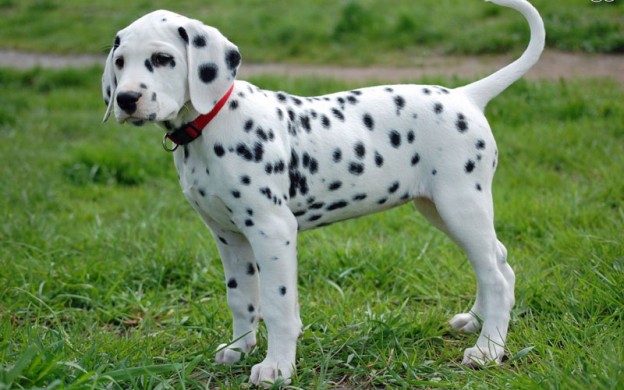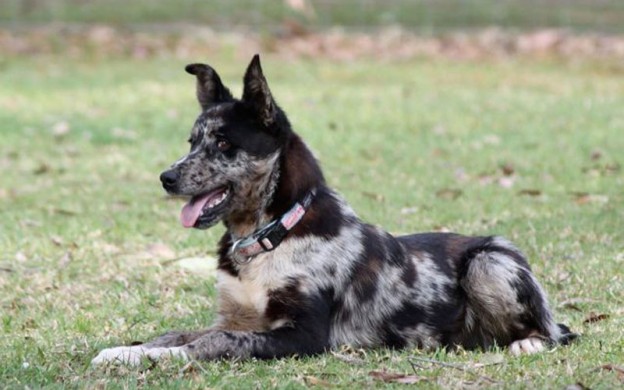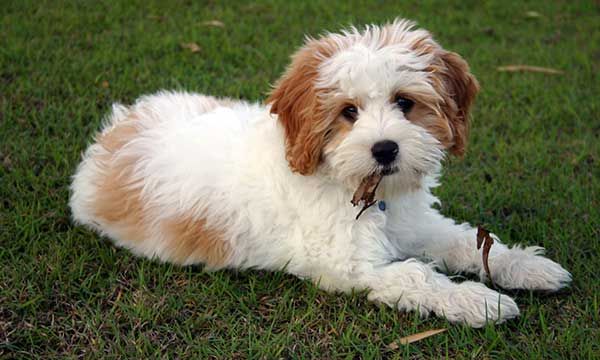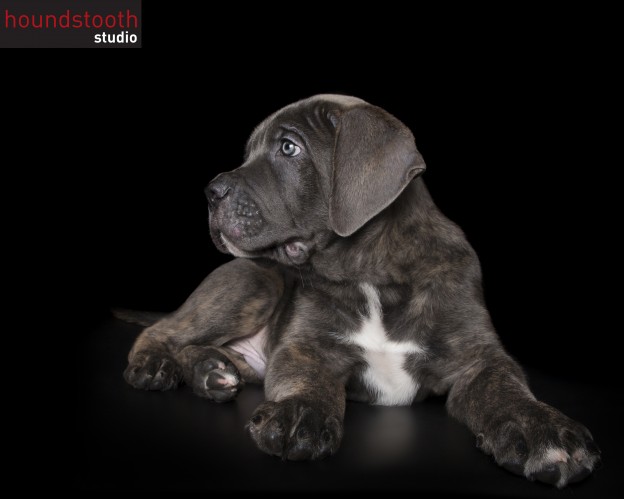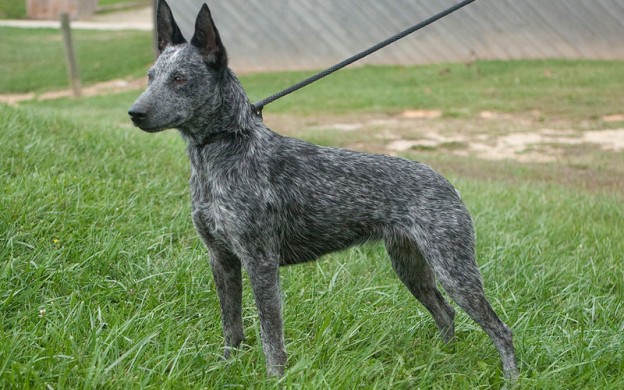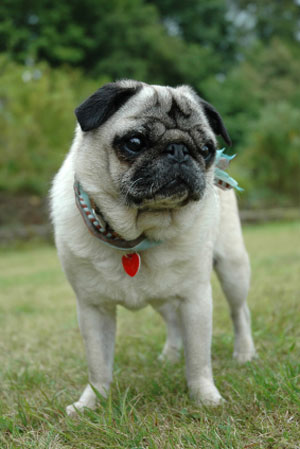
Pug dogs are gentle in nature and are great as a family pet.
Facts
Personality: These little dogs will have you in stitches with their attention seeking comedy acts. They are made of heart-melting goodness with great temperament and inquisitive nature.
Suitability: Great for singles or family environments that are looking for a charismatic companion. Pugs are best suited to people who have a lot of time and love to give as the breed thrives on human affection. They are tolerant and gentle with children, but like all breeds they should be supervised when interacting with any little ones.
Favourite Activities: Getting their paws into anything you are doing! These little shadows will take great delight in following you around the home and helping with the housework, but they also love to get out and meet new friends, both doggy and human.
Watchdog Qualities: Pugs will bark to let you know when visitors arrive but they are generally very friendly towards all humans, be they friend or foe.
Backyard Requirements: Pugs need very little space and will happily live in an apartment as long as they get a walk each day. The do not like extreme heat or cold, and would prefer to live inside the home.
Looking for a friend? You’ll find one in the Pug; the most wonderful companion in the world according to Pug fanatics. And Pug aficionados agree that while many breeds are faithful and loyal, the lovable Pug takes top prize for these attributes.
Bred specifically as a companion dog, the Pug is a lot of dog packed into a little body. In fact, this breeds stocky, thickset and muscular-looking body, closely resembling the Mastiffs in style, could lead some to believe the Pug is a fighter. However, nothing could be further from the truth. With its distinctive, large, pool-like eyes and irresistible wrinkled face, this little pooch was born to love, filling its home with affection, humour and fun. It will stick close to those it loves, often pressing up against its owner just to feel them, burrowing in for a cuddle and often sprawling across one of its favourite places of all the human lap!
Felicity Way, from Canberra, has owned and shown Pugs for 20 years, as well as being a national and international judge of the breed. In her opinion, the best thing about these little dogs is their love of humans and their fantastic nature.
Each one is an individual, with its own quirks, likes and dislikes, explains Felicity. We’ve had many other breeds, but the day the Pug came into our lives it captivated our household.
Felicity stresses this is not a breed for people who are too busy to put in time and effort, emphasising that the Pug is definitely a house dog.
This animal was originally bred to live in temples, she says. That’s its heritage. This is not a dog for the yard or an outside kennel. Its human-oriented and needs to be with its owners.
Adelaide-based Patsy Muirden has owned and shown Pugs since 1956 and agrees that this dog is meant to be part of its owners life.
The Pug should never be kept in kennels or on concrete, states Patsy. In fact, their lot in life is to be a person!
Despite the fact that Patsy is now in her seventies, her Pugs still feature prominently. Her five-year-old Champion Patrian Chaucer took out Best in Show in both the 1998 and 1999 Pug Specialty in Melbourne. And what is it about these dogs that has kept her captivated for so many years?
Its their predictability, says Patsy. They’re so easy to live with. They don’t bark at every little thing and they’re not highly strung or excitable. They’re intelligent and have great personalities. And by the way, she adds, one Pug deserves another! After all, there needs to be two so they can rest their chins on each other.
While the Pug is easy to look after, owners need to maintain a degree of vigilance to ensure their pets remain healthy. For example, heat and humidity are the Pugs enemies and can prove lethal in some situations. The Pugs cooling system is limited due to its flat face and the dog can easily overheat. Similarly, they dislike the cold and are prone to catching colds. And while this breeds to-die-for eyes can melt the hardest of hearts, they can be the Pugs undoing if owners aren’t watchful.
New South Wales Pug expert and international show judge Kerry Cannon, who bred Don Burkes Pug Ralph, can’t stress enough the importance of guarding a Pugs prominent and therefore easily damaged eyes.
This dog is wonderful around children, but kids can be rough and they can easily damage a Pugs eyes, she says. Some experts even warn about the presence of cats and suggest that any pointy or dangerous objects lying around be removed or they could inadvertently poke the large exposed surface of a Pugs eye.
As for the theory that Pugs eyes pop out, Absolute nonsense, claims Kerry. Pugs eyes are bulbous so it could be easier for their eyes to pop out than those of some other breeds, but the dog would have to be grabbed by another dog for it to happen. In all my time connected with this breed, I have only known of two dogs whose eyes have popped out. Unlike some other breeds, such as the King Charles Spaniel, this problem is not prevalent in the Pug.
Can one lose sleep if bombarded nightly by the famous Pug snore? They do snore, but so do old people, laughs Kerry. She stresses that the breed does not have a breathing problem and is perfectly healthy if looked after properly. Sometimes you can hear a Pug panting away, but that’s often caused by heat, which causes stress, making the dog pant. Its not a breathing problem.
Snoring, common in many short-nosed breeds, simply comes with Pug territory and has to be accepted. Some owners even get to enjoy the sound. I love it. To me its such a soothing sound, enthuses one Pug lover.
According to Felicity Way, Pugs will snore in varying degrees and it does take some getting used to. But, she adds, its all part of the special Pug package. Pugs love all members of a family but often they get especially attached to one person, she relates. That’s the case with me and my Pug Bert. Sometimes hes like an immovable rock. He stretches out across three-quarters of my bed, leaving me a very generous one-quarter for the night.
The Pug comes in a variety of solid colours, ranging from fawn to apricot and silver, with a black mask on the face and black ears. Black Pugs, which some say can be noisier and more mischievous than others, should have no markings. The head should be large and round with clearly defined wrinkles and a short, flat muzzle.
The tightly curled tail sits over the hip and can become very animated in an excited Pug. The dogs eyes are prominent, expressive and dark. They should not be overly moist and if they appear so, should be checked by a vet.
When it comes to training, the Pug will catch on fairly quickly but does have a stubborn streak. Being a dog that is known to sell its soul for a tasty morsel, however, food rewards for good behaviour can go a long way. (Beware of overfeeding as the food-loving Pug is prone to obesity.)
While the Pug can fulfil the role of watchdog, barking if the doorbell is rung or when a stranger approaches the house, the Pug Club of Victoria warns the dog is likely to lick a burglar to death, despite its initial deep barks and growls.
Experts recommend early socialisation and obedience training, but warn that when it comes to toilet training in cold weather, your Pug could baulk at the idea of going out in the cold and the rain. Having a dry area for toilet-training could be beneficial.
Michael Bay, from Melbourne, still laughs nostalgically when he thinks about his pet Pug Tamar who, together with the familys Chihuahua (which was named Hercules), used to keep them in fits of merriment. Tamar was a member of our family for many years, recalls Michael, and she was very much an integral part of all our lives. We used to call her the vacuum cleaner because she would race around the house, nose to the floor, and because of her flat face it was almost as if she was vacuuming as she moved. When she finally died, an old lady, she left a big gap in all of us. She was really gorgeous.
Origin
Its believed the Pug first appeared in China, where there was a short-coated Pekingese-type dog known as the Happa-dog, which may well have been the forebear of our modern Pug. They were reportedly in China as far back as 1115 BC, but it wasnt until 663 BC that short-mouthed dogs are mentioned. They were often treated like royalty and were kept by the emperors.
Some varieties of Pug eventually found their way to the continent, particularly Holland, probably through the Dutch East India Company. Pugs appeared in England in about 1688 and their popularity spread, with courtiers parading their dogs adorned with orange ribbons. They remained a popular breed into the reign of George III (1760-1820), when his wife Charlotte kept large numbers.
Later, the breeds popularity began to wane and by 1867 it seemed cross-breeding was leading to the Pugs demise. But the little dog had a resurgence in popularity in the Victorian era.
Its believed the Pug came with migrants to Australia in the 1860s. The first record of them being shown was at the Sydney Royal Show in 1870.
Royal pugs
The Duke and Duchess of Windsor were Pug fanatics, owning 11 over the years and amassing a huge collection of Pug memorabilia. They were known to have sheets embroidered with the word Pug, engraved leashes, numerous paintings of Pugs, a gold matchbox holder with the names of some of their Pugs engraved on it, porcelain Pugs, porcelain dog bowls decorated with pictures of Pugs, Pug paperweights, even letter openers decorated with images of the much-loved pooch.
A few years ago, the Windsors collection was auctioned by Sothebys, with bidders paying well into the thousands for the various items. Most went for more than the reserve, with Pug lovers snapping up treasured pieces of Pug royal history. A much cherished portrait of the Duke of Windsor and one of his adored Pugs went way past its expected price, finally selling for $18,400.
Grooming
It doesn’t take long to groom a Pug but they do love to be brushed and fussed over. I groom my Pugs with a soft bristle brush, a velvet mitt, a bottle of baby oil and a box of tissues.
Twice a week I brush with the soft brush to eliminate dead hair and dirt from the coat. Once the dead hair is removed, I brush with the velvet mitt which enhances the coats lovely shine. Fawn Pugs have a double coat which takes a little longer to brush than the single black coat.
Once a week I clean the face, paying attention to the nose roll (the roll of fat that sits on top of the Pugs nose). Dab your tissue in some baby oil and gently rub under the nose roll. You’ll be amazed how much dirt and grime collects here.
The Pug also enjoys a bath and loves to be roughed up while being dried. I bath my Pugs regularly once a month in winter is adequate, and weekly in summer, mainly because they enjoy it so much!
A loyal friend
The Pug is renowned for its loyalty, with stories abounding of its death-defying attempts to protect its owners. In 1572 in Holland, Prince William of Oranges life was saved when his beloved pet Pug set about trying to warn the prince of the approaching Spaniards. The little dog, which slept beside the prince, apparently barked and licked its owners face to try to wake him.
The Pug also rose to fame in 18th century France when it became much adored by Napoleons wife, Josephine. When she was later imprisoned, she apparently sent messages, tucked under her Pugs collar, to Napoleon. And rumour has it that the famous Pug bit Napoleon when he entered Josephines room on the night of their wedding!
Breed Care
Daily: Pugs should be provided with a balanced diet. Provide clean, fresh water and make sure the dog always has shade or a cool place for hot days. Being a brachycephalic breed flat-faced it could become stressed if left in the sun for prolonged periods.
Weekly: Bathing in summer. Facial care. Twice-weekly grooming.
Monthly: Heartworm and flea treatment.
Other: Gastrointestinal worming for adult dogs every three months, more frequently during puppyhood. Annual vaccinations.
Hereditary diseases: Include wry mouth, hemi vertebrae, hip dysplasia, disticea and entropian. Buying from a registered breeder who tests for hereditary diseases can help lessen the risk of purchasing a dog with problems.



